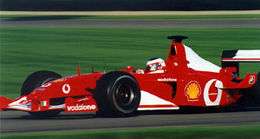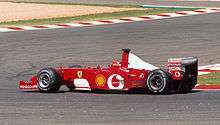Ferrari F2002
 | |||||||||||
| Category | Formula One | ||||||||||
|---|---|---|---|---|---|---|---|---|---|---|---|
| Constructor | Ferrari | ||||||||||
| Designer(s) | Ross Brawn, Rory Byrne | ||||||||||
| Predecessor | F2001 | ||||||||||
| Successor | F2003-GA | ||||||||||
| Technical specifications | |||||||||||
| Chassis | Moulded carbon fibre & Honeycomb composite structure | ||||||||||
| Suspension (front) | Independent suspension, pushrod activated torsion springs | ||||||||||
| Suspension (rear) | Independent suspension, pushrod activated torsion springs | ||||||||||
| Length | 4,495 mm (177 in) | ||||||||||
| Width | 1,796 mm (71 in) | ||||||||||
| Height | 959 mm (38 in) | ||||||||||
| Engine | Ferrari Tipo 051/B/C , 3.0 L (3,000 cc; 183 cu in) , V10 (90°) @ 19,000 RPM , Naturally Aspirated , in a mid-mounted, rear-wheel drive layout | ||||||||||
| Transmission | Semi-automatic Sequential Limited-slip Differential Gearbox Seven Speed Forward + One reverse | ||||||||||
| Power | 820–900 horsepower (610–670 kW) @ 19,000 RPM | ||||||||||
| Weight | 600 kg (1,323 lb) | ||||||||||
| Fuel | Shell Fuel | ||||||||||
| Lubricants | Shell Lubricant | ||||||||||
| Brakes | Carbon brake discs, pads and calipers | ||||||||||
| Tyres |
BBS Racing Wheels : 13" | ||||||||||
| Competition history | |||||||||||
| Notable entrants | Scuderia Ferrari Marlboro | ||||||||||
| Notable drivers |
1. 2. | ||||||||||
| Debut | 2002 Brazilian Grand Prix | ||||||||||
| |||||||||||
| Constructors' Championships | 2 (2002 & 2003) | ||||||||||
| Drivers' Championships | 2 (2002 & 2003) | ||||||||||
The Ferrari F2002 was one of the most successful Formula One car designs of all time. Designed by Ross Brawn, Rory Byrne and Paolo Martinelli, it won fifteen Grands Prix, from a total of nineteen races in 2002 and 2003.
The car was much lighter than its predecessor, the F2001. Powered by a 3.0 litre V10 engine which had a very low centre of gravity, the F2002 had excellent handling. The new 051 engine was not the strongest engine of 2002, but it was lighter, more compact, very fuel efficient and very driveable. Bridgestone developed special tyres, suited specifically for the car. Aerodynamically, the Ferrari was well ahead of the contemporary Williams-BMW but perhaps a little down on power, and on a par with, or slightly ahead of the 2002 season's McLaren car.
Using the Pomeroy Index system, Motor Sport magazine recently determined that the F2002 is the fastest Formula One car of all time. However, the Ferrari F2004 achieved better qualifying laptimes at 12 of the courses which were raced by both cars (only the 2002 French Grand Prix, 2002 Belgian Grand Prix and 2002 Japanese Grand Prix were faster than the 2004 races, with two of these being due to rain).
Team personnel behind the F2002
The majority of the conceptual design work for the Ferrari F2002 was by Ferrari's legendary South African chassis designer Rory Byrne and the engine design by Ferrari's Paolo Martinelli. The project was overseen by the team's technical director Ross Brawn. A vast army of other team personnel oversaw the running of the team and the project.
Concept and design
Prior to the introduction of the F2002, Ferrari had used a revised version of their championship winning Ferrari F2001 for the first few races of 2002.
The F2002 was not only a development of the championship-winning Ferrari F2001, but a completely revolutionary model involving many technologies not seen previously. Since the late 1990s Ferrari had been using the same basic concept and design of gearbox and although this had been used to win drivers and constructors titles from 1999 onwards the technical team pushed ahead with a new version instead. The new replacement gearbox casing was made of ultra lightweight and higher strength titanium, thus reducing its weight by as much as 15% and lowering the car's centre of gravity. The new compact design allowed for great advancement in the bodywork and increasing the car's aerodynamic efficiency at the rear.
However such was the extent of the gearbox casing redesign that the aerodynamic work was left behind schedule and initially did not represent the same performance gains as the mechanical engineering. Thus Ferrari continued its design for another two months and only first used the F2002 at the third round of the 2002 season having been using the previous year's F2001 chassis, albeit with many alterations and the inclusion of the Ferrari 051 2002 engine.
Other advancements on the car include the clutchless direct shift technology within the gearbox, a new fluid traction control system to replace the previous 2001 traction control system, and upright aerodynamically shaped periscopic exhaust outlets at the rear. The latter technology was incorporated both to use the hot exhaust gases for aerodynamic effect and to raise these gases higher and out the way of the rear suspension. On previous occasion Ferrari's non chimneyed top exiting exhaust outlets had caused the rear suspension and other elements at the rear of the car to overheat or even melt when minor cracks occurred.
Race history

At its first race in Brazil, the F2002 was victorious, being driven by Michael Schumacher and continuing Ferrari's trend since 1999 for its cars to win on their debut. Michael Schumacher clinched second on the grid and after a first lap altercation with Juan Pablo Montoya, took a somewhat easy win from his brother Ralf's Williams. There was some controversy surrounding tyre allocation because the team only had one F2002 chassis at the race. Therefore, Schumacher's spare car was an F2001 chassis and because the two chassis used different wheel rim designs each required separate wheels and tyres. It was thus argued that Schumacher had in-effect twice the allocation of tyres as any other driver. The controversy was managed by Ferrari agreeing to aggregate their tyre usage between the two cars, ensuring that Schumacher used the same total number of tyres as all the other drivers.
What followed was a season of domination, the likes of which had not been seen since McLaren's 1988 season. With the F2002, Schumacher scored 9 more victories, his total of 11 wins was a record for the season, while Rubens Barrichello scored four. The only race that the car failed to win was at Monaco, while the F2001 did not take the Malaysian GP. Furthermore, Schumacher finished every race on the podium, never finishing lower than second with the F2002. The German won the world championship in record time, clinching the title at the 11th race of the season in France. The two Ferrari drivers were comfortably first and second in the Drivers' Championship, and Ferrari scored as many points (221) as the rest of the teams put together.
Such was Ferrari's dominance that Schumacher and Barrichello were criticized for swapping finishes at Austria and United States - an event that would provoke a ban on 'team orders' for the following seasons, and would be raised again in 2010 when Ferrari were fined after appearing to instruct Felipe Massa to allow Fernando Alonso to win the German Grand Prix.
The F2002 (renamed the F2002B) was still competitive at the beginning of 2003, and Schumacher took the car's last win in the San Marino Grand Prix before it was replaced by the F2003-GA for the next race. The F2003-GA was not quite as successful as the F2002, and Schumacher only won the title by two points over McLaren's Kimi Räikkönen.
Complete Formula One results
(key) (results in bold indicate pole position; results in italics indicate fastest lap)
| Year | Entrant | Chassis | Engine | Tyres | Drivers | 1 | 2 | 3 | 4 | 5 | 6 | 7 | 8 | 9 | 10 | 11 | 12 | 13 | 14 | 15 | 16 | 17 | Points | WCC |
|---|---|---|---|---|---|---|---|---|---|---|---|---|---|---|---|---|---|---|---|---|---|---|---|---|
| 2002 | Scuderia Ferrari Marlboro | F2002 | Ferrari 051 V10 | B | AUS | MAL | BRA | SMR | ESP | AUT | MON | CAN | EUR | GBR | FRA | GER | HUN | BEL | ITA | USA | JPN | 221* | 1st | |
| Michael Schumacher | 1 | 1 | 1 | 1 | 2 | 1 | 2 | 1 | 1 | 1 | 2 | 1 | 2 | 2 | 1 | |||||||||
| Rubens Barrichello | 2 | DNS | 2 | 7 | 3 | 1 | 2 | DNS | 4 | 1 | 2 | 1 | 1 | 2 | ||||||||||
| 2003 | Scuderia Ferrari Marlboro | F2002B | Ferrari 051B V10 | B | AUS | MAL | BRA | SMR | ESP | AUT | MON | CAN | EUR | FRA | GBR | GER | HUN | ITA | USA | JPN | 158** | 1st | ||
| Michael Schumacher | 4 | 6 | Ret | 1 | ||||||||||||||||||||
| Rubens Barrichello | Ret | 2 | Ret | 3 |
* 207 points with the F2002
** 32 points scored with the F2002B
References
- Hughes, M. 2007. Over-ruled?. Motor Sport. LXXXIII/3, p. 44
- Henry, Alan (ed.) (2002). AUTOCOURSE 2002-2003. Hazleton Publishing Ltd. pp. 44–48. ISBN 1-903135-10-9.
External links
| Wikimedia Commons has media related to Ferrari F2002. |
| Awards | ||
|---|---|---|
| Preceded by Ferrari F2001 |
Autosport Racing Car Of The Year 2002 |
Succeeded by Bentley Speed 8 |